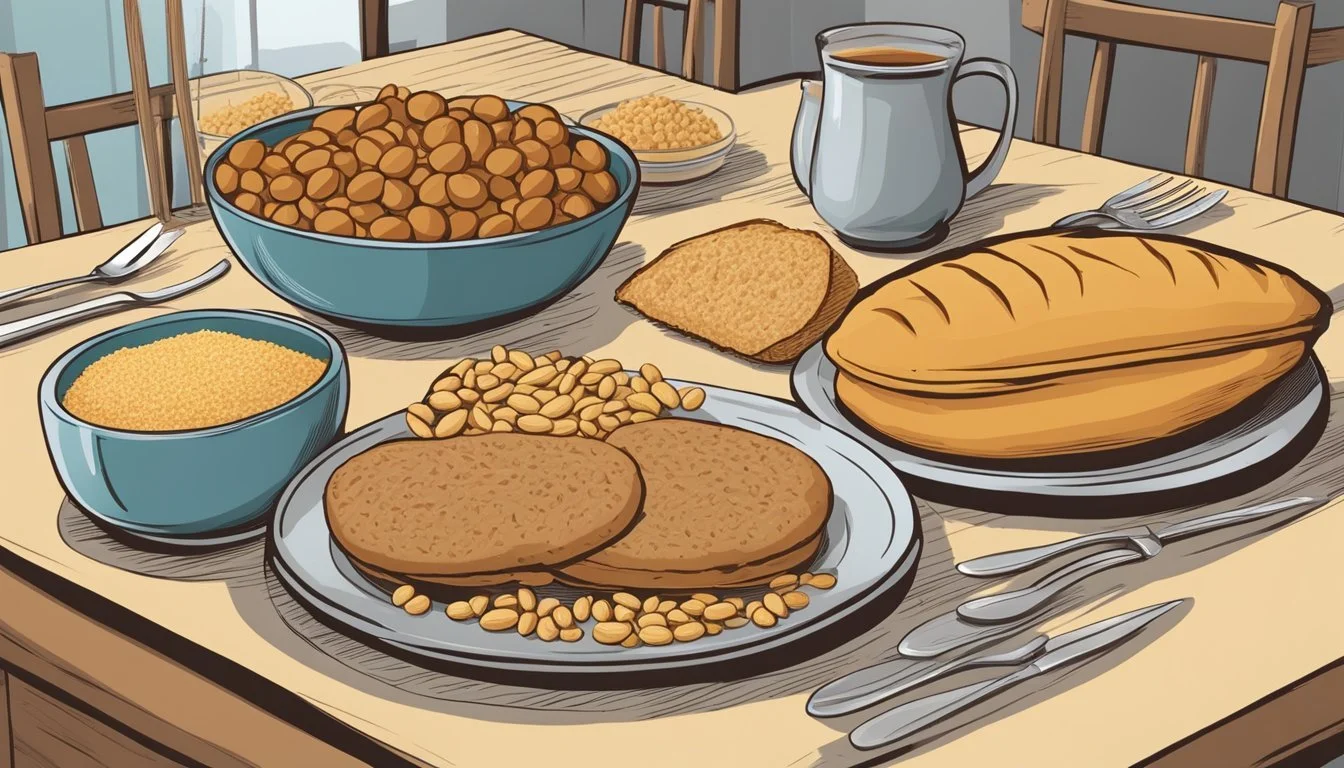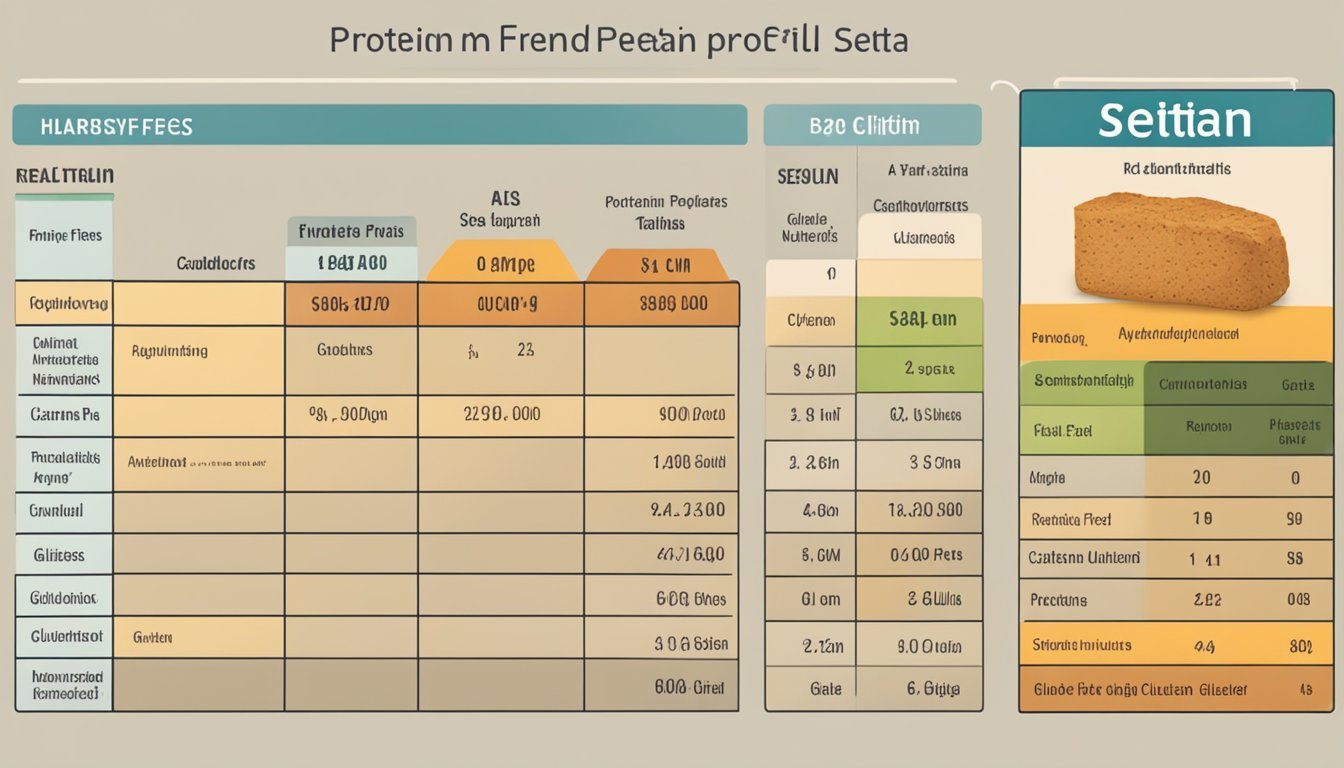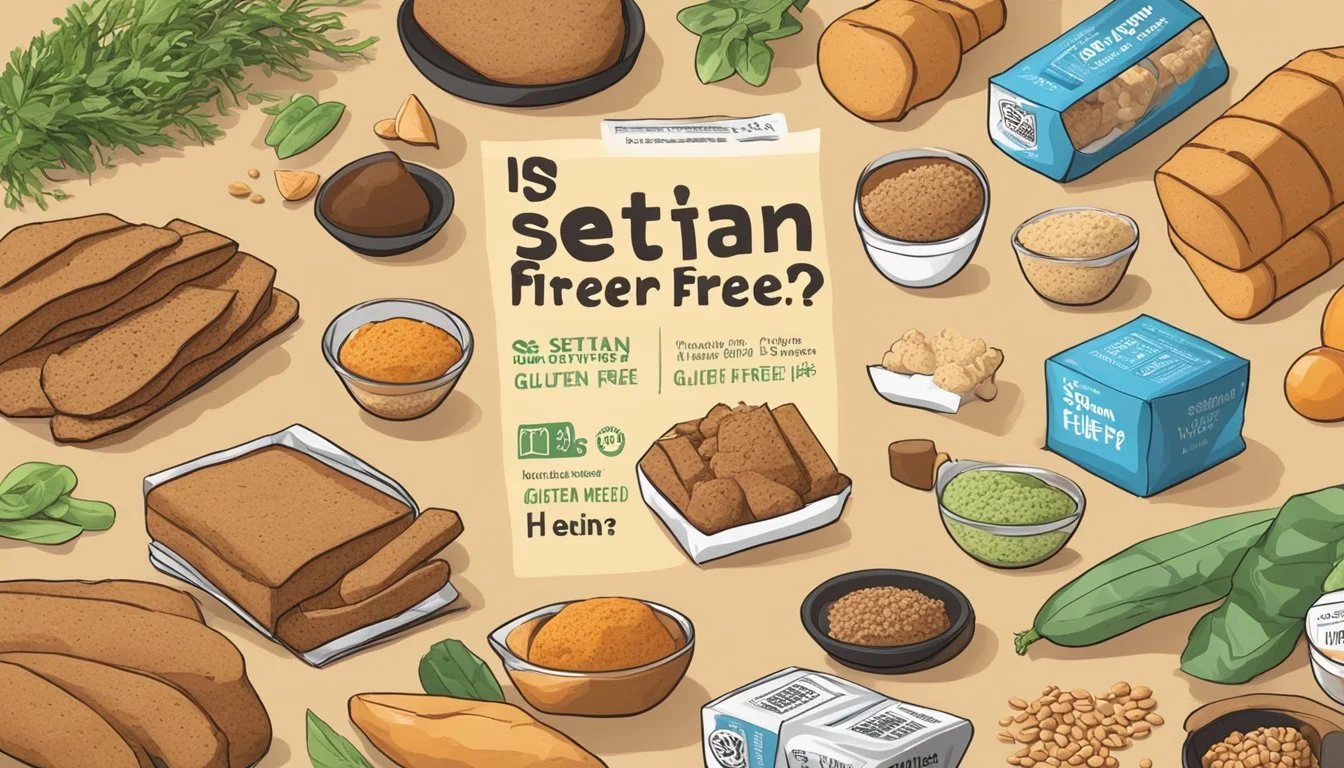Is Seitan Gluten-Free?
Understanding Plant-Based Protein Options
Seitan (What wine goes well with seitan?) is a popular meat substitute derived from vital wheat gluten, making it a protein-rich food item often used in vegetarian and vegan diets. Due to its origins from wheat gluten, traditional seitan is not gluten-free, which poses a concern for individuals with celiac disease or gluten sensitivities. It is also a key consideration for those who opt for a gluten-free lifestyle, as the inclusion of seitan in their diet could lead to adverse health effects.
However, innovative cooking methods and recipes have emerged that create gluten-free versions of seitan. These alternatives typically involve using a combination of gluten-free flours such as rice flour, chickpea flour, or potato flour to mimic the texture and function of wheat gluten in recipes. It is important to note that while these substitutions provide a gluten-free option, the texture and taste may differ from traditional seitan.
Consumers seeking gluten-free seitan options should be vigilant when purchasing store-bought products or when dining out, as it is crucial to ensure that the seitan is truly gluten-free and has not been cross-contaminated with gluten-containing ingredients. Making gluten-free seitan at home could offer a safer and more controlled method to include this meat alternative in a gluten-free diet.
What Is Seitan?
Seitan, commonly recognized as a versatile meat substitute, is particularly significant within vegan and vegetarian diets due to its high protein content. Originating from ancient culinary practices, it has found its modern niche as a substitute for meat products like chicken and beef.
Origins of Seitan
Seitan is believed to have been developed by Buddhist monks in China as a meat alternative. The traditional method involves washing wheat flour dough with water to remove the starch granules, leaving the sticky insoluble gluten as an elastic mass which is then cooked before being eaten.
Seitan as a Meat Substitute
Seitan's meaty texture makes it a popular protein source for those following a vegan or vegetarian lifestyle. Because it's made from wheat gluten, it's often used to mimic the texture of chicken or beef in a variety of dishes. Rich in protein but lacking some essential amino acids, seitan is often used in conjunction with other protein sources to create a well-rounded diet.
Understanding Gluten
Gluten is a group of proteins found in wheat that gives dough its elasticity and affects the texture of baked goods. Its role in seitan and its implications for certain health conditions are important for consumers to understand.
Role of Gluten in Seitan
Gluten, specifically wheat gluten, is the cornerstone of seitan. Seitan is created by rinsing wheat flour dough in water until all starch granules are removed, leaving behind a sticky mass of pure gluten protein. This gluten is then shaped and cooked, taking on a chewy texture similar to that of meat, which is why it's favored as a vegetarian and vegan meat substitute.
Ingredients leading to gluten formation in seitan:
Wheat flour: The primary source of gluten.
Water: Used to separate gluten from wheat flour.
Gluten and Health Considerations
For individuals with celiac disease, ingesting gluten damages the small intestine, preventing nutrient absorption. Those with wheat allergies may experience immediate allergic reactions to wheat proteins. Non-celiac gluten sensitivity is characterized by symptoms similar to celiac disease but without the intestinal damage. Even without these conditions, some people report irritable bowel syndrome or other food sensitivities linked to gluten consumption.
Health implications of consuming gluten:
Celiac disease: Autoimmune response to gluten that damages the small intestine.
Wheat allergy: Immunologic reaction often causing hives, difficulty breathing, and other allergy symptoms.
Non-celiac gluten sensitivity: Symptoms similar to celiac disease without the associated intestinal damage.
Irritable bowel syndrome: Non-specific digestive symptoms that may be exacerbated by gluten.
Increased intestinal permeability: Also known as "leaky gut," where gluten can affect the lining of the intestines, allowing toxins and bacteria to enter the bloodstream.
In conclusion, understanding the role of gluten is crucial for those who wish to consume seitan or have specific health concerns when it comes to gluten intake. Seitan, made from wheat gluten, is not suitable for individuals with gluten-related disorders.
Is Seitan Gluten-Free?
Seitan is traditionally made from wheat gluten and is not gluten-free. However, there are ways to prepare seitan that cater to a gluten-free diet by using alternative flour sources.
The Misconception of Gluten-Free Seitan
The term "gluten-free seitan" can lead to confusion because seitan is inherently a product made from vital wheat gluten, which is the protein extracted from wheat. Vital wheat gluten is high in protein but also contains the very gluten that individuals on a gluten-free diet must avoid, particularly those with celiac disease. Moreover, even though gluten-free options for seitan are becoming more popular, they do not contain traditional seitan but are instead made from gluten-free ingredients that mimic the texture of seitan.
Traditional Seitan Ingredients:
Vital wheat gluten
Wheat flour or wheat starch
Gluten-Free Alternatives:
Rice flour
Chickpea flour
Beans
Considerations for Gluten-Free Diets
When considering seitan for a gluten-free diet, one's health requirements must be at the forefront. People with celiac disease cannot tolerate gluten, a protein found in wheat, barley, and rye. Therefore, those with celiac disease or non-celiac gluten sensitivity must carefully read labels and ensure that any seitan or meat substitute claimed to be gluten-free truly omits all sources of gluten and is produced in a facility free from cross-contamination.
Key Points for Gluten-Free Diets:
Confirm no cross-contamination in manufacturing
Look for certified gluten-free labels
Be aware of alternative names for wheat or gluten-containing ingredients
Making Seitan at Home
Creating seitan at home involves a straightforward cooking process and allows for ample customization of flavors to suit individual preferences. The basic method requires mixing vital wheat gluten with water and seasonings to form a dough, which is then cooked to develop its signature meaty texture.
Basic Seitan Recipe Steps
Ingredients:
Vital wheat gluten
Water
Soy sauce or tamari
Bouillon cube or powder
Seasonings (e.g., garlic powder, onion powder)
Preparation:
In a mixing bowl, combine the vital wheat gluten with a selection of dry seasonings, such as onion powder, garlic powder, black pepper, sage, and thyme.
Gradually add water to the dry mix, stirring until a dough forms.
Cooking:
Shape the dough into loaves or cutlets as desired.
Fill a large pot with water, adding soy sauce or tamari and a bouillon cube for flavor. Bring to a low boil.
Place the dough into the simmering broth, cover, and let it cook for 45-60 minutes. The longer it cooks, the firmer its texture will become.
Finishing:
Remove the seitan from the water and allow it to cool.
Once cooled, the seitan can be sliced, diced, or used whole in a variety of recipes.
Customizing Seitan Flavors
Broth: The flavor of seitan can be greatly impacted by the broth used during its cooking process. One can use vegetable, "chicken," or "beef" flavored broth, or enhance the water with ingredients like garlic slices, bay leaves, and various other spices.
Spices: Adding a blend of traditional spices such as garlic powder, onion powder, sage, thyme, and black pepper directly into the vital wheat gluten mix alters the seitan's taste from the inside.
Marinades: After cooking, seitan's neutral taste benefits from marination. Marinating seitan in a mixture of flavors can trade its inherent blandness for a savory or spicy profile, depending on the seasonings used.
Baking: For a chewier texture, some opt to bake the seitan after boiling. This step can help in intensifying the flavors as well as changing the outer texture, giving it a skin-like crust.
Alternatives to Seitan
Seitan is a popular meat substitute for vegans and vegetarians, but as it's made from wheat gluten, it's not suitable for those on a gluten-free diet. Here are some noteworthy alternatives that cater to different dietary needs.
Plant-Based Protein Sources
Tofu: Made from soybeans and a staple in many plant-based recipes, tofu is a versatile protein source that can be seasoned and cooked in various ways to mimic the texture and flavor of meat.
Tempeh: Another soy-derived option, tempeh has a firmer texture and nuttier flavor, making it a hearty component in various vegan dishes.
Plant-Based Chicken and 'Meat' Crumbles: These processed substitutes are designed to closely replicate the texture and taste of their meaty counterparts, often using soy, pea protein, or other plant-based ingredients.
Soya Chunks: Known for their meat-like consistency, soya chunks are dehydrated soya beans that can be rehydrated and used in a multitude of dishes.
Gluten-Free Meat Substitutes
Textured Vegetable Protein (TVP): TVP is a highly versatile gluten-free product made from soy flour, acting as an excellent meat replacement while providing a substantial amount of protein.
Jackfruit: This tropical fruit has a unique meaty texture, making it a favorite gluten-free substitute in pulled pork-style dishes and other savory recipes.
Mushrooms: With their umami flavor profile, mushrooms can be utilized as a flavorful, gluten-free alternative to seitan, particularly in stews and stir-fries.
Lentils: These legumes are not only gluten-free but also a good source of protein and fiber, ideal for adding substance to plant-based recipes.
Beans and Chickpea Flour: These ingredients can create patties or "meatballs" as a gluten-free, protein-rich option suitable for a variety of dishes.
Nutritional Profile of Seitan
Seitan is a concentrated source of wheat-based protein, especially favored in vegetarian and vegan diets. Typically, one serving of seitan, which is about 100 grams, contains around 75 grams of protein. This substantial amount surpass the protein provided by many meat products, making it a highly regarded option for those who eschew animal proteins.
Apart from its impressive protein content, seitan is relatively low in fat, containing minimal amounts of saturated fat. It stands out as a low-carbohydrate food, making it a potential option for low-carb diets. However, individuals should be conscious of the potential for high sodium content, which varies depending on the preparation method of the seitan.
The caloric value of seitan is moderate; a serving can contain approximately 370 calories. This caloric content is primarily due to its protein and minimal fat ratio. While seitan doesn't naturally contain a wide range of minerals, it does offer some micronutrients, including iron and calcium. The fortification of commercial seitan products can enhance these mineral contents.
Here is a brief breakdown of the nutritional elements per 100-gram serving of seitan:
Protein: 75g
Calories: 370
Fat: 1.9g
Saturated Fat: 0.2g
Carbohydrates: 8.2g
Iron: 4.2mg
Calcium: 142mg
Sodium: Variable, check product labeling
Individuals looking for a meat substitute that aligns with high protein needs often turn to seitan for its robust profile. However, due to its wheat derivation, seitan is not gluten-free and should be avoided by those with celiac disease or a gluten intolerance.
Seitan in Different Cuisines
Seitan has become a popular meat substitute in various cuisines, appreciated for its chewy texture and versatility. It is particularly prevalent in Asian and Western cuisines, where it often stands in for meat in vegan recipes.
Seitan in Asian Cuisine
In Asian cuisine, seitan has a long history, particularly in China and Japan, where it is known for its role in vegetarian dishes (What wine goes well with vegetarian dishes?). China is often credited with the origin of seitan, where it has been used in Buddhist cooking for centuries. Traditionally, it is made from washing wheat flour dough with water until all the starch granules have been removed, leaving the sticky gluten behind.
Method: The gluten is then shaped and cooked, commonly by steaming, boiling, or frying.
Dishes: It features prominently in stir-fries, noodle dishes, and as a protein source in dim sum.
In Japan, seitan is called "fu" and is a common ingredient in dishes like sukiyaki and shabu-shabu. It’s notable for its:
Japan's special touch: Slightly different preparation, leading to subtle variations in texture and flavor.
Use: Both festive and everyday meals, providing an alternative to those following a plant-based diet.
Seitan in Western Cuisine
Seitan's versatility has allowed it to seamlessly integrate into Western cuisine, especially among vegan and vegetarian populations seeking meat-like options. Its ability to absorb flavors makes it ideal for a wide array of recipes.
Adaptability: Seitan can be seasoned and shaped to mimic various types of meat, from sausages to burger patties.
Occasions: It is frequently featured in holiday dinners, providing a centerpiece option for those abstaining from animal products.
In addition to everyday meals, seiten's chewy and substantial texture has made it a favorite in vegan comfort food, with restaurants often featuring it in sandwiches, stews, and barbecue dishes. The ingredient demonstrates an impressive capacity to cross cultural boundaries, adapting to the tastes and culinary practices of each region it touches.
Buying and Storing Seitan
When purchasing seitan, scrutinize the label for added ingredients and storage recommendations, often dictated by whether it is dry, refrigerated, or frozen. Proper storage is crucial for extending its shelf life and maintaining its quality.
Where to Buy Seitan
Seitan can be found in various forms, including dried, refrigerated, or frozen. It is commonly available at:
Health food stores
Grocery stores, in the refrigerated section alongside tofu and tempeh
Online retailers
When buying seitan, one should examine the label for nutritional content, presence of added sugars, salt, or fats, and any allergen information, especially gluten, as seitan primarily consists of wheat gluten.
Storing and Shelf Life
Refrigeration is key to maintaining seitan's freshness. The steps for storing seitan include:
Airtight Containers: Store seitan in an airtight container to prevent exposure to air and moisture.
Broth Storage: If the seitan comes in a broth, ensure both the seitan and broth are refrigerated promptly.
Shelf Life: Unopened refrigerated or frozen seitan typically lasts up to a week or according to the expiration date. Once opened, consume seitan within 3 to 5 days for best quality.
Remember, the cooler the storage, the longer the seitan retains its ideal taste and texture. Always return leftovers to proper storage conditions immediately after use.
Seitan on Social Media
Social media platforms have become key spaces for sharing seitan recipes and promoting plant-based diets. Influencers and food bloggers utilize these channels to engage with audiences interested in vegan alternatives and healthy eating.
Sharing Seitan Recipes
On platforms like Instagram, Facebook, and Pinterest, individuals can find a diverse array of seitan recipes. Recipes range from simple seitan steaks to elaborate themed dishes. Users often share their culinary creations, highlighting the versatility of seitan in vegan cooking. Social media allows for rapid dissemination of these recipes, making it easy for followers to access them and integrate seitan into their diets.
Instagram: Visual posts with step-by-step photos and videos.
Pinterest: Pinboards dedicated to seitan dishes for various occasions.
Facebook: Community groups where members exchange tips and recipes.
Plant-Based Diet and Lifestyle Influencers
Influencers on social media who advocate for a plant-based diet often incorporate seitan into their content. They discuss its benefits, nutritional value, and share how it can be used to mimic the texture and protein content of meat in vegan recipes. These influencers have a significant impact on their followers' eating habits by showcasing seitan as a staple food in plant-based diets.
Key Influencers: Profiles with large followings and engaging content.
Content Variety: Posts include recipe videos, health tips, and lifestyle advice.
Community Interaction: Influencers often engage with their audience through Q&As, live cooking demonstrations, and recipe challenges.
Creative Uses for Seitan
Seitan, a versatile protein-rich meat alternative, excels in vegan cuisine due to its adaptability in texture and flavor. This wheat-based product can mimic many traditional meat dishes when creativity meets cooking.
Seitan in Vegan Recipes
Seitan is a staple in vegan cooking for its ability to replicate the chewy texture of meat, making it ideal for a plethora of dishes. Below is a list of vegan recipes where seitan proves its versatility:
Sandwiches and Wraps: Seitan can be sliced or shredded to make the perfect filling for sandwiches and wraps, topped with an array of salads and sauces.
Stir-Fries: For a quick and nutritious meal, seitan can be stir-fried with vegetables and served with rice or noodles.
Seitan Roast: A seitan roast can serve as a centerpiece for a festive meal, seasoned with herbs and spices to taste just like traditional roasts.
Innovative Seitan Dishes
The creativity in cooking with seitan opens the door to innovative dishes that amaze even the non-vegans. Here are some distinctive ways to prepare seitan:
Kebabs: Marinated chunks of seitan can be skewered and grilled, mimicking the texture of meat kebabs, perfect for barbecues.
Hot Dogs: Ground seitan, when seasoned and shaped, can create a vegan version of hot dogs, exceeding expectations in taste and appearance.
Faux Seafood: With the right seasonings and cooking techniques, seitan can adopt the flavor of various seafood dishes, (What wine goes well with seafood dishes?) broadening its culinary uses.
By incorporating seitan into vegan recipes or innovating with unique dishes, seitan stands out as a leading component in the future of plant-based cooking.
Frequently Asked Questions
In addressing common queries, it is crucial to understand that while traditional seitan is not gluten-free, alternative methods and ingredients allow for gluten-free options. Methods to enhance flavor with various seasonings are also available to cater to different tastes.
How to Pronounce Seitan?
Seitan is pronounced as "say-tan." The correct pronunciation enables clear communication and avoids confusion when discussing this food item, especially in culinary settings.
How to Make Seitan without Gluten?
To make gluten-free seitan, one substitutes traditional wheat flour with gluten-free flours such as rice flour, chickpea flour, or potato flour. The process involves:
Creating a dough: Mix the chosen gluten-free flour with water to form a dough similar in texture to traditional wheat dough.
Cooking: Steam, bake, or simmer the dough until it achieves a firm, meat-like consistency.
What Are the Best Seasonings for Seitan?
Seitan's neutral flavor makes it a versatile base for a wide array of seasonings and spices. Some popular options include:
Soy sauce or tamari: For a deep, umami flavor, especially for gluten-free tamari.
Garlic powder and onion powder: For a robust and aromatic taste.
Smoked paprika: To add a smoky dimension to the seitan, akin to barbecued meats. (What wine goes well with barbecued meats?)
Nutritional yeast: For a cheesy, nutty flavor profile, often used in vegan cooking.
For the best results, one should mix these seasonings into the dough or create a marinade that allows the seitan to absorb the flavors.









